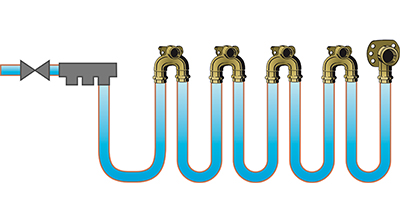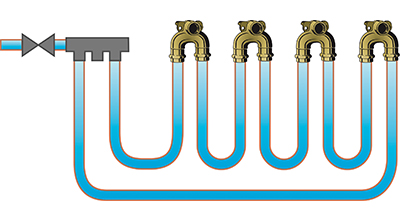Minimizing microbial colonization in plumbing supply systems has become increasingly important in the plumbing industry in recent years. This is done largely through the control of temperature and flow maintenance. Plumbing engineers, installers and facility operators are particularly concerned with Legionella, a waterborne bacterium that causes a very serious type of pneumonia called Legionnaires’ disease. In the U.S., an estimated 56,000 to 113,000 people are infected with the Legionella bacteria each year. In public water systems, the EPA regulates 88 different contaminants including microbial contaminants, disinfection byproducts, organic and inorganic compounds and radionuclides.
Health care facilities are often targeted as major hotspots for spreading water system-related illnesses. However, it is important for all buildings with multiple housing units and centralized hot water systems, such as college dorms or high-rise apartment complexes, to have a plan in place to keep water moving and mitigate the risk of spreading these diseases.
 The Viega SmartLoop internal recirculation system.
The Viega SmartLoop internal recirculation system.
Two of the biggest culprits of waterborne illnesses are stagnation and improper water temperature. Stagnation in water distribution systems is a problem in most modern buildings, but it is a larger problem where immune-compromised patients can be found coexisting with piping dead ends and inconsistent occupancies that lead to periods of stagnation. Stagnation can lead to a buildup of biofilms and pathogens, which can ultimately damage the system, causing health problems for those exposed.
With continuous (or even intermittent) flow, there is an exchange of fresh water, which reduces stagnation in the system and helps maintain temperature closer to the desired temperature. Even with recirculation, stagnation can occur in dead legs because of the lack of water exchange. By maintaining water flow and keeping temperatures out of the Legionella growth range, engineers and installers can greatly reduce the risk. This article will explore some of the best practices for maintaining flow and temperature to minimize microbial growth and will focus efforts on reducing colonization, not just treating a bacterial problem once it’s established and detected.
Maintaining temperature control
Maintaining water temperatures outside of the growth range for Legionella makes it difficult for the bacteria to colonize. The bacteria cells become unable to reproduce at temperatures above 122 F. At temperatures above 131 F, the bacteria begin to die. The issue is complicated by the biofilm in which the bacteria may live. Because it is a protective insulating film, bacteria within the biofilm may not be subject to elevated system temperatures. This is especially important when thermally disinfecting a system.
For thermal disinfection to be effective, all Legionella cells in the system must be subject to temperatures of approximately 160 F for at least five minutes, including within the biofilm itself, or the disinfection process will be incomplete, leading to future recolonization.
Similarly, with chemical disinfection, disinfectants can only kill what they come in contact with. This is why it is important to try to prevent microbial growth and biofilm formation in the first place. Good design can enable all parts of the system to be maintained at a temperature above the highest colonization temperature, thereby reducing the possibility of bacteria to multiply.
Hot water and hot water recirculation piping should be insulated to prevent excessive heat loss. Depending on the ambient temperature near the piping, insulating cold water piping may also be considered. All plumbing should be installed in such a way as to minimize heat transfer between pipes at different temperatures. Grouping well-insulated pipes of similar temperature together can further reduce unwanted heat transfer that could place water in prime temperature range for the proliferation of Legionella and other waterborne pathogens.
Maintain flow
Maintaining flow offers several key benefits for plumbing systems. First, water in motion can make it harder for bacteria to establish itself along the pipe wall. When immersed in flow, bacteria do not have the opportunity to settle on the pipe surface. Second, water exchange can help maintain temperature. Stagnant water that is allowed to cool is displaced with higher temperature fresh water from the heating source, making it easier to maintain temperature. This also reduces the wait for hot water at the fixture, promoting user comfort and convenience. Stagnant water also means that residual disinfectant in the water system will decrease and will not be evenly dispersed. If the water keeps moving through the system, the disinfectant will follow.
Recirculate
Dead legs can result in stagnation because the water trapped in a dead leg is not subject to flow for extended periods and not exchanged with fresh water. Once stagnant, water temperatures will reach that of the surrounding environment, which, in most cases, lies exactly in the temperature range conducive to Legionella colonization.
One way to promote a consistent supply temperature in a hot water system is to use recirculation. If balanced so that all parts of the system are subject to the design flow rate calculated to offset heat loss, this strategy can work well for risers and mains.
Branches and dead legs can pose a challenge for maintaining specific water temperatures, even with the use of a recirculation system that maintains temperature in risers and mains. It’s not always possible to recirculate branch lines. It’s even less likely to be able to recirculate drops serving fixtures. This means that in a branch-and-tee system, dead legs are inherent to the design. Dead legs pose an ideal environment for microbial growth: stagnant water at steady state ambient temperatures within the Legionella growth range.
 Using flow-through fittings in a series installation reduces the potential for stagnation in supply lines of unused fixtures.”
Using flow-through fittings in a series installation reduces the potential for stagnation in supply lines of unused fixtures.”
There are several effective recirculation strategies that help minimize dead legs, one of which is to pipe individual fixtures in series. In other words, installers should daisy chain one fixture to the next. Using flow-through fittings in a series installation compared to standard branch-and-tee moves the tee closer to the fixture, reducing the potential for stagnation in supply lines of unused fixtures. With the most used fixture at the end of the series, anytime that fixture is used, it causes flow in the remaining fixtures upstream up to their point of connection whether they are used or not. What would normally be served by a dead leg because of non-use would now see flow through normal occupant habits even if that fixture itself is not used.
 Ring installations utilize flow-through fittings by circulating fresh water through the supply piping of other unused fixtures.”
Ring installations utilize flow-through fittings by circulating fresh water through the supply piping of other unused fixtures.”
If the most-used fixture is not known, the group of fixtures could be fed from two different directions, resulting in a ring. In this way, any fixture used on the ring will cause flow from both directions regardless of how close the fixture is to the branch, minimizing stagnation for a bank of fixtures.
So, as the requirements and customer demands continue to increase in the North American plumbing industry, plumbing system designers and installers should be mindful of all the new ways to combat the risk of waterborne diseases. New solutions will have to be implemented to address modern trends in the plumbing market such as Legionella.
Treatment solutions alone will not necessarily eliminate the risk of microbial colonization within a plumbing system. Design and installation professionals should consider all options to minimize the potential for risks to occur in the first place.





